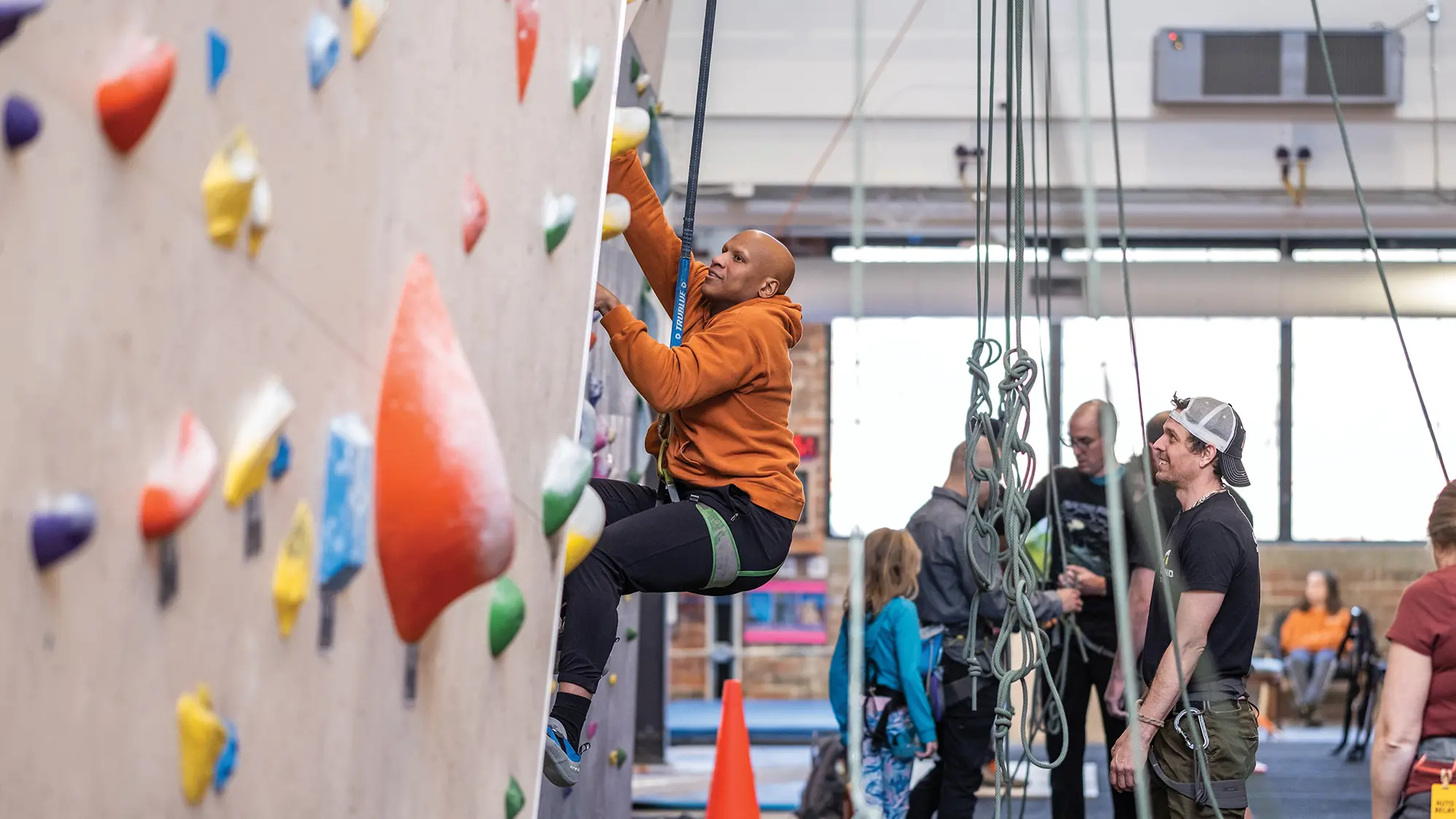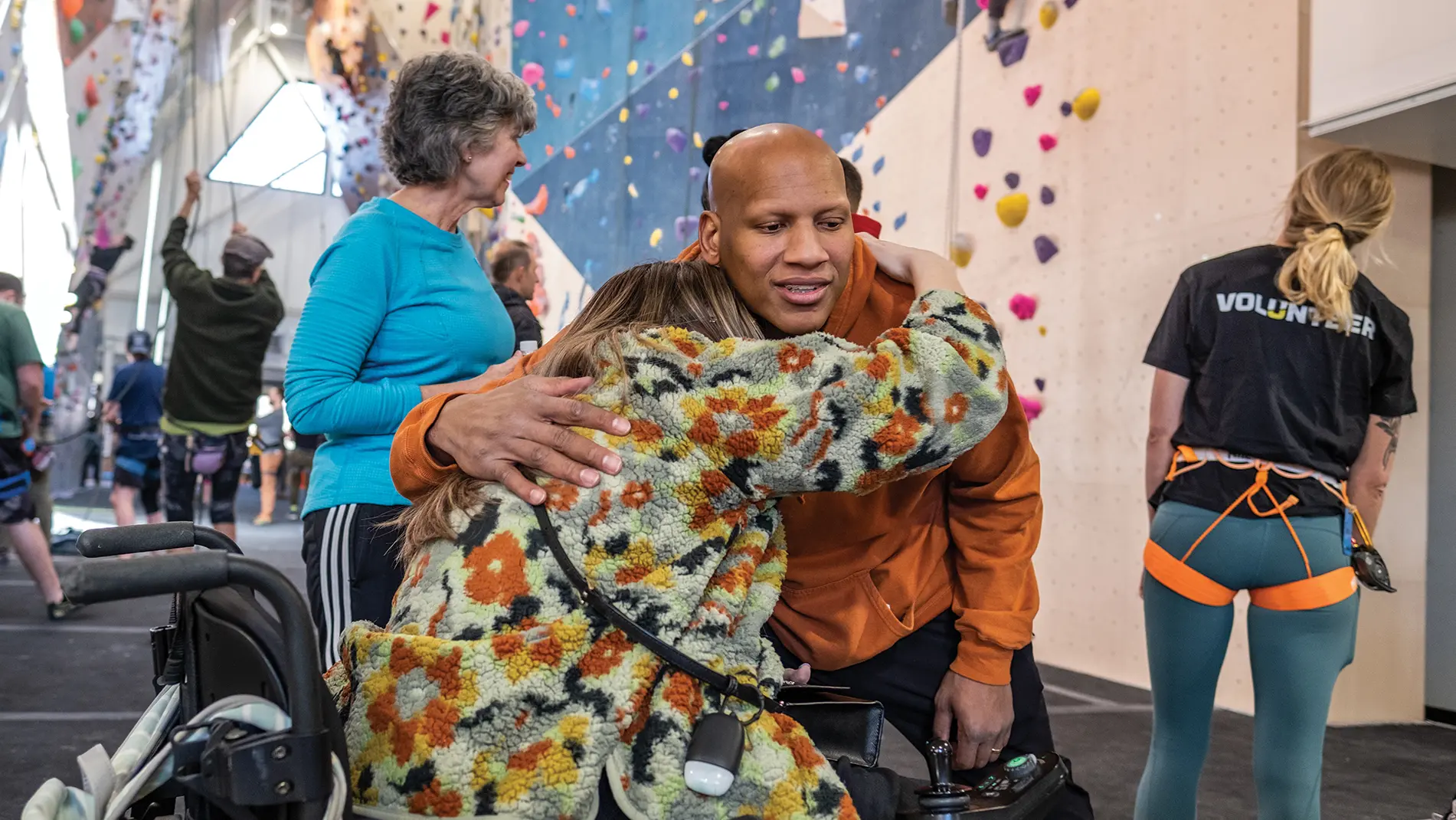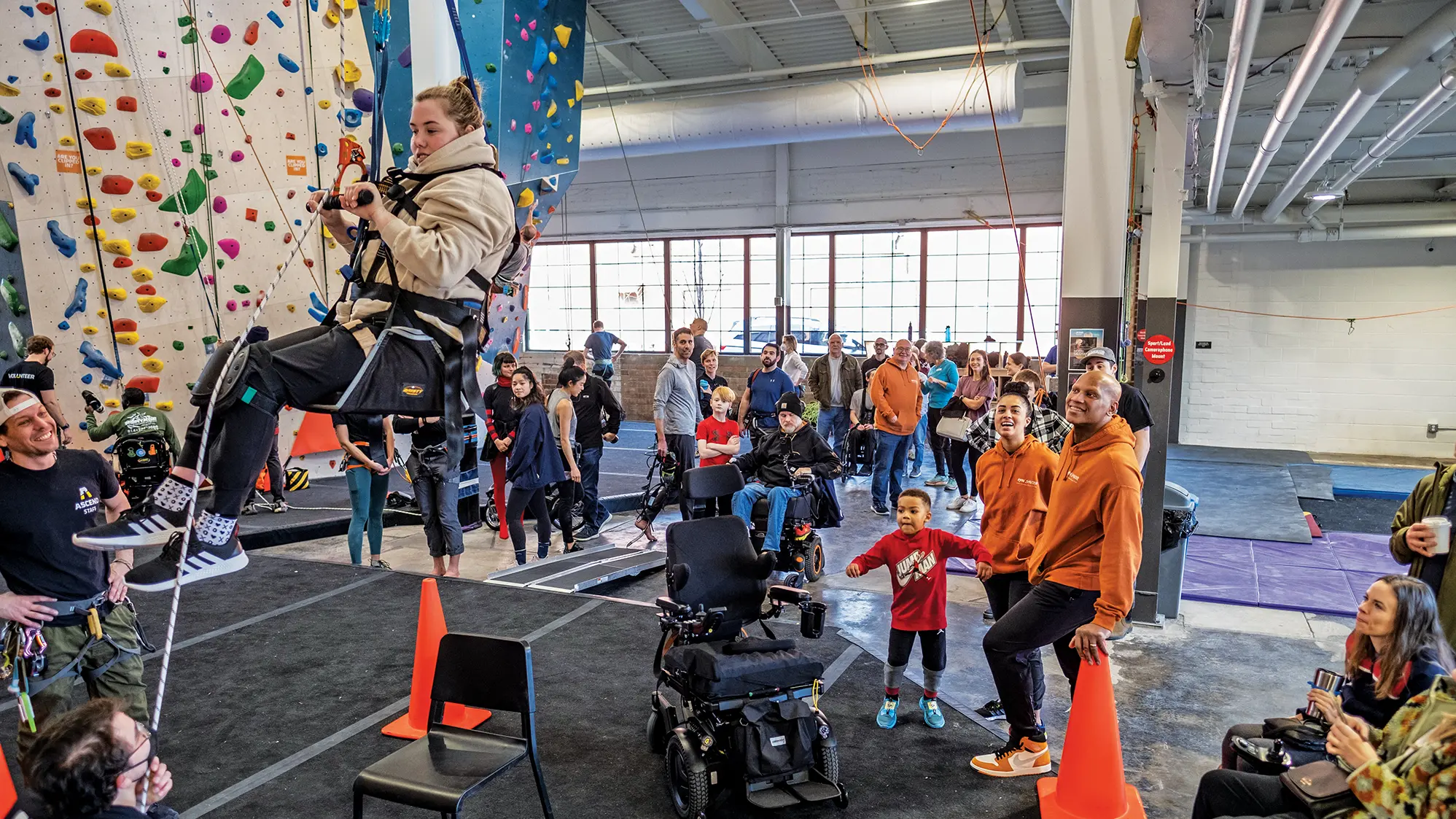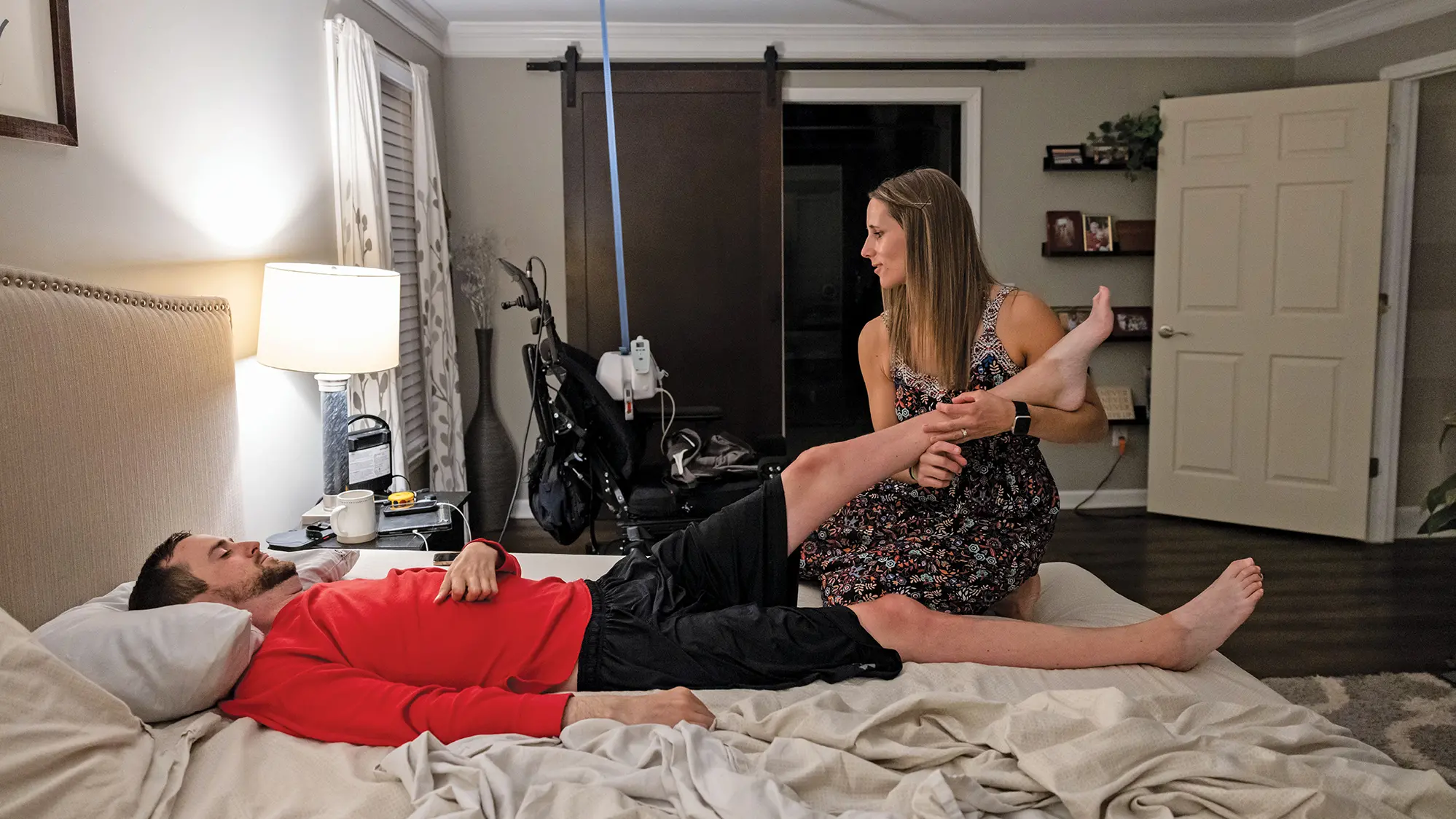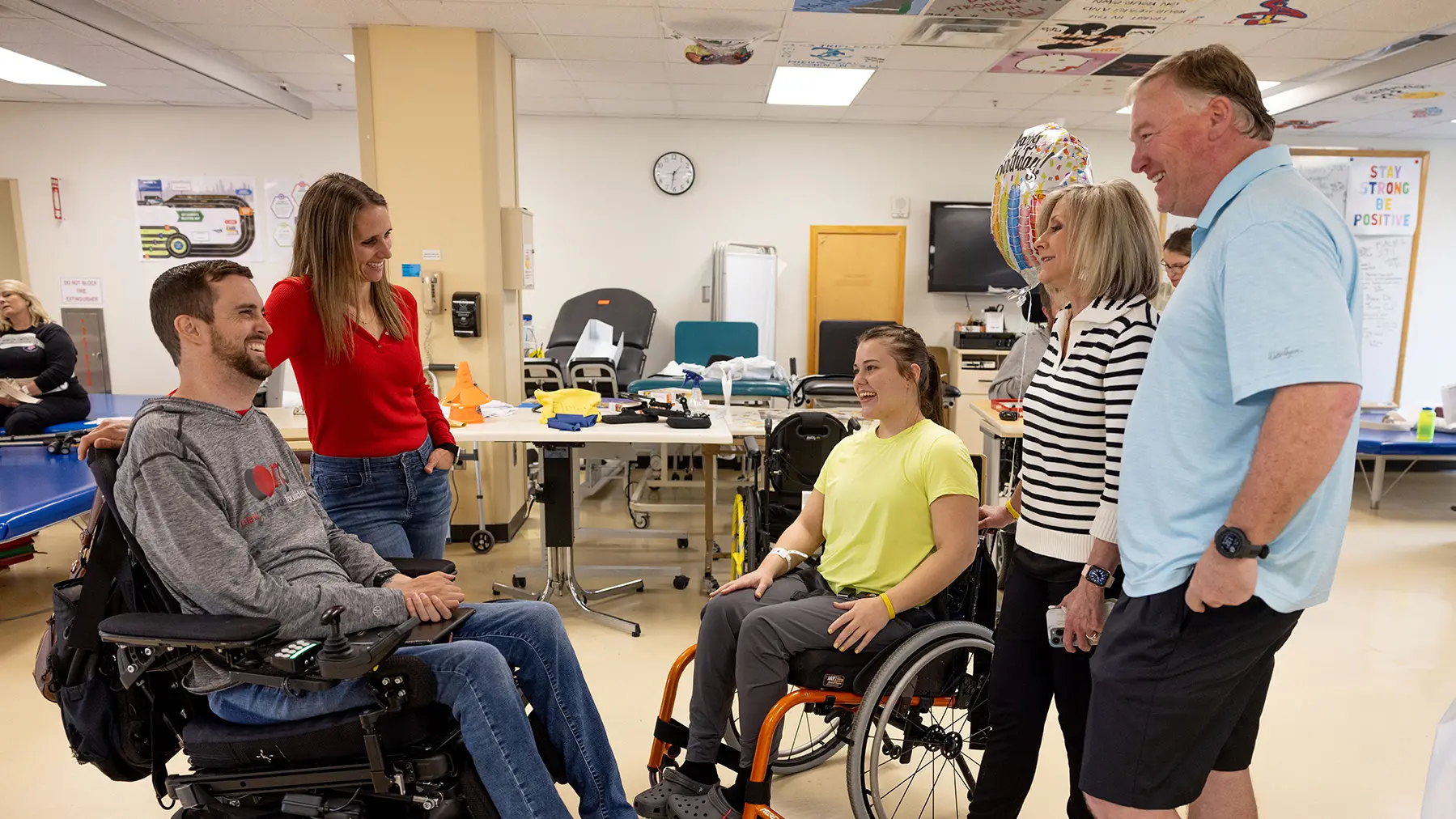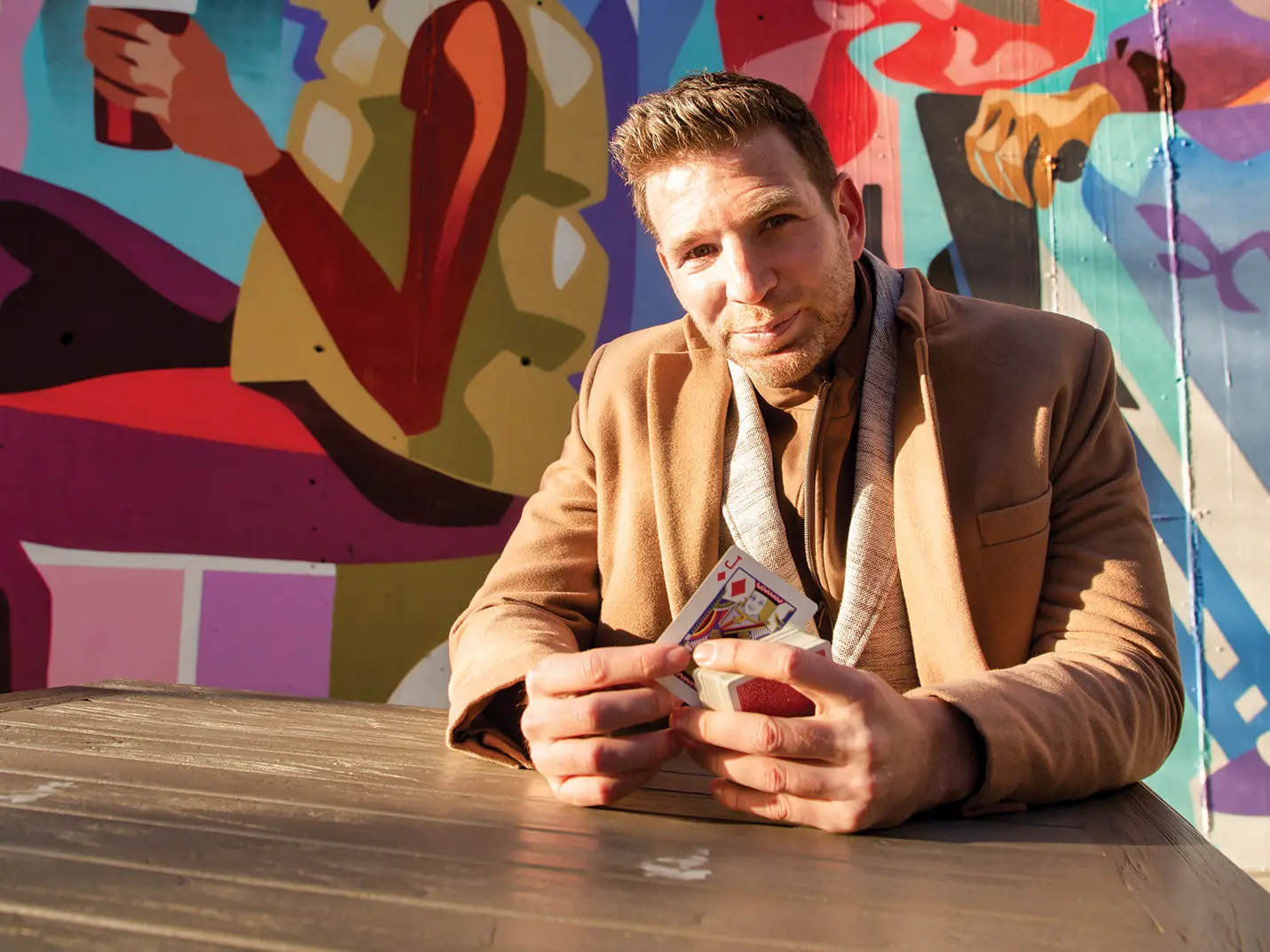

Ryan Shazier and Tyson Gentry are hope embodied
Spinal cord injuries ended the football careers of these two alumni but gifted them with an understanding of how to help fellow survivors.
“This is about people who understand each other.”
PITTSBURGH — Ryan Shazier is 30 feet above the ground, strapped into a harness and considering options for which rock hold on the indoor climbing wall to reach or step toward next.
“It’s tough positioning myself in the right place,” Ryan says.
A voice rings out below him. “Come on, Ryan,” Zach Schmude yells. “You got this. Lift it!”
Zach is in a wheelchair, paralyzed since a construction job accident two months earlier shattered vertebrae and severed his spinal cord. He’s still flushed from the excitement of scaling the climbing wall himself with the help of adaptive equipment minutes earlier.
About a dozen other people in wheelchairs sit nearby. They’re talking, smiling, laughing — enjoying a social gathering that offers respite from the daily mental and physical challenges of their paralysis.
The Ryan Shazier Fund for Spinal Rehabilitation hosted this event at Ascend Climbing. The former Ohio State and NFL player created the foundation in November 2020 — nearly three years after a spinal cord injury ended his pro football career — to provide people who have experienced spinal cord injuries, and their caregivers, with the emotional support, resources and funding they need to gain independence and fulfillment in their daily lives.
“It’s unfortunate what happened to me. Sometimes I get sad or frustrated,” says Ryan, a team captain, all-Big Ten and All-America player during the final two seasons of his Ohio State football career that spanned 2010 through 2014. “It hurts that I can’t play football anymore, but it has been a blessing that I was able to recover and can now help other people.”
A first-round draft pick of the Pittsburgh Steelers, Ryan was a two-time All-Pro linebacker when he was injured December 4, 2017, while making a tackle during a Monday night game in Cincinnati. He sustained a spinal contusion, or a crushing of the spinal cord, which paralyzed his lower body and led to two surgeries and three months in the hospital.
Feeling eventually returned to Ryan’s legs, and he regained the strength to not only walk, but dance with his bride, Michelle Rodriguez, at their wedding in May 2019. His new life came with a fresh perspective.
“My injury definitely allowed me to be more relatable and allowed me to see through other people’s eyes,” Ryan says. “As an athlete, I was kind of just focused on how I see things and trying to get better at my craft every single day. Well, since I’ve been injured, I see what other people go through — what their lives are like and how tough things can be. It’s allowed me more empathy and understanding.”
Curiosity led to that broadening of his view during his intensive rehabilitation at the University of Pittsburgh Medical Center Rehabilitation Institute. Ryan befriended fellow patients and wondered why some weren’t at rehab sessions five days a week, as he was. They told him about systemic barriers, such as a lack of transportation to appointments and insurance coverage limiting them to 20 or 30 rehab sessions.
“It wasn’t fair for those individuals to not get the same opportunities as me,” says Ryan, who had 130 rehab sessions while covered by NFL insurance.

The Shazier Fund team meets to plan retreats for families. From left are Executive Director Caroline Boyce and Ryan and Michelle Shazier. (Photo by Jodi Miller)
Moved to action by those patients and their caregivers and families, Ryan created his foundation, which has grown to serve Pittsburgh, western Pennsylvania and, most recently, eastern Ohio and Columbus.
“Ryan always has to be a part of change — a change for the better,” Michelle says.
One of the many ways Ryan helps is by creating opportunities for emotional support. His foundation holds a weekend retreat twice a year for people with spinal cord injuries and their families or caregivers. They’re also welcomed to events such as the adaptive climbing day, where about 25 people found much-needed camaraderie.
“We’re all best buds,” says Jaclyn Lenhart, paralyzed in 2021 by transverse myelitis, an inflammation of the spinal cord. “It has been nice to know others who are going through the same thing. We can ask questions of each other that we don’t want to ask the doctors. We can ask about personal experiences.”
And they can be heard.
“This is about people who understand each other,” Ryan says, “and we build a community around it so we can help each other grow.”
Ryan is leaning forward in his seat, hands clasped, eyes focused intently on his audience in a lunchroom at the UPMC Rehabilitation Institute in downtown Pittsburgh, where he spent two months recovering from his temporary paralysis.
About 10 spinal cord injury patients on this therapy floor are gathered in front of Ryan, whose success with the Steelers provides a scent of local celebrity, yet not a whiff of ego. He didn’t bring along a superhero cape, nor a prepared speech or notes. Instead, he spends more than an hour taking their questions.
His answers are baked in encouragement, but also hardwired with frankness, particularly a story about his tough-guy attitude meeting reality. He recounts being in pain a week after his injury, unable to push his body upright, so sick that he vomited on himself and a friend sitting at his bedside.
“That was the lowest point of my life,” he says. “When that happened, I was like, ‘Yeah, I’m in really bad shape.’”
The tale prompts a hush before Ryan fills the void by asking questions of the patients about their own conditions, which spurs conversation.
“I’ve learned to understand that one thing doesn’t fit all,” Ryan says. “Everybody has a different story, a different challenge.”
His inquisitiveness infuses his foundation’s Golden Window Program, which is a stipend-based support system for individuals with spinal cord injuries. Preference is given to those in the first two years of injury — which research shows is the best window of time for gains — or who have no other means of financial support. Eligible participants receive up to $15,000 for physical rehabilitation, mental health support, durable medical equipment, and home and vehicular adaptation.

Patient Kaytlin Dixon poses with, from right, Ryan and University of Pittsburgh Medical Center workers Grace Kresky and Gizelle Townsend. Ryan regularly visits the center’s Rehabilitation Institute, where he had 130 rehab sessions. (Photo by Jodi Miller)
“We allow them to define what’s important to them and what can allow them to get back on the track they want to be on,” Ryan says. “I’m trying to be able to provide multiple solutions for individuals after learning from them what’s best for them.”
The first of 32 Golden Window recipients was Gianni White, 19, and his mother, Georgia. Gianni was paralyzed from the waist down after being shot in May 2021. Ryan’s foundation paid for his adaptive driving lessons, installed hand controls in his car and renovated his Pittsburgh home’s bathroom for accessibility. He has since graduated from high school and now drives to and from work.
“This all has brought me peace,” Gianni says. “It has also shown I’m not the only one going through this.”
Ryan, 30, fosters that connection through a foundation program called “Ryan Time” in which he speaks to individual spinal cord patients and their families by phone or video call every Thursday.
“He listens to us,” Jaclyn says. “He knows my family. He actually cares.”
During his visit to the UPMC Rehabilitation Institute, Ryan listens as a woman in a wheelchair describes her mental health challenges and then puts him on the spot.
“Do you have anxiety and depression?” she asks.
“I did deal with depression, to be honest,” Ryan replies. “That was kind of tough for me to overcome. It’s still difficult when you’re dealing with what we’re dealing with.”
The late morning sun shines brightly through the hospital windows behind him.
“Lean on each other. Build relationships. Gain new experiences. Don’t feel isolated,” he says. “A lot of people with spinal cord injuries lock themselves into a box, almost like a prison. Once you get yourself out, you meet more people, you allow yourself the opportunity to flourish.”
Ryan is flat on his back on a mat, breathing heavily after coming down from a trip up the climbing wall.
“Whoa. I’m tired, man,” he says.
Above him is Crystal Rackowski, 32, paralyzed since December 2020 when she fractured a vertebra after her car slid on black ice and crashed into a tree.
Now, her wheelchair sits empty as she uses her arms to hoist herself with a pulley and ropes. Cheers erupt when she reaches the top of the 42-foot wall.
“That’s awesome,” Ryan says as he watches.
Crystal’s face is aglow after she descends to the floor, where she talks about once being a gymnast and how empowering she found the climbing wall outing.
“It’s great to be part of something and not excluded,” Crystal says.
Around her conversations crackle among others with spinal cord injuries, their families and caregivers.
“I feel like, as a community, we all just got thrown into a bad situation that we never expected,” Ryan says. “Now we’re all trying to figure out how to get the best out of it together.”
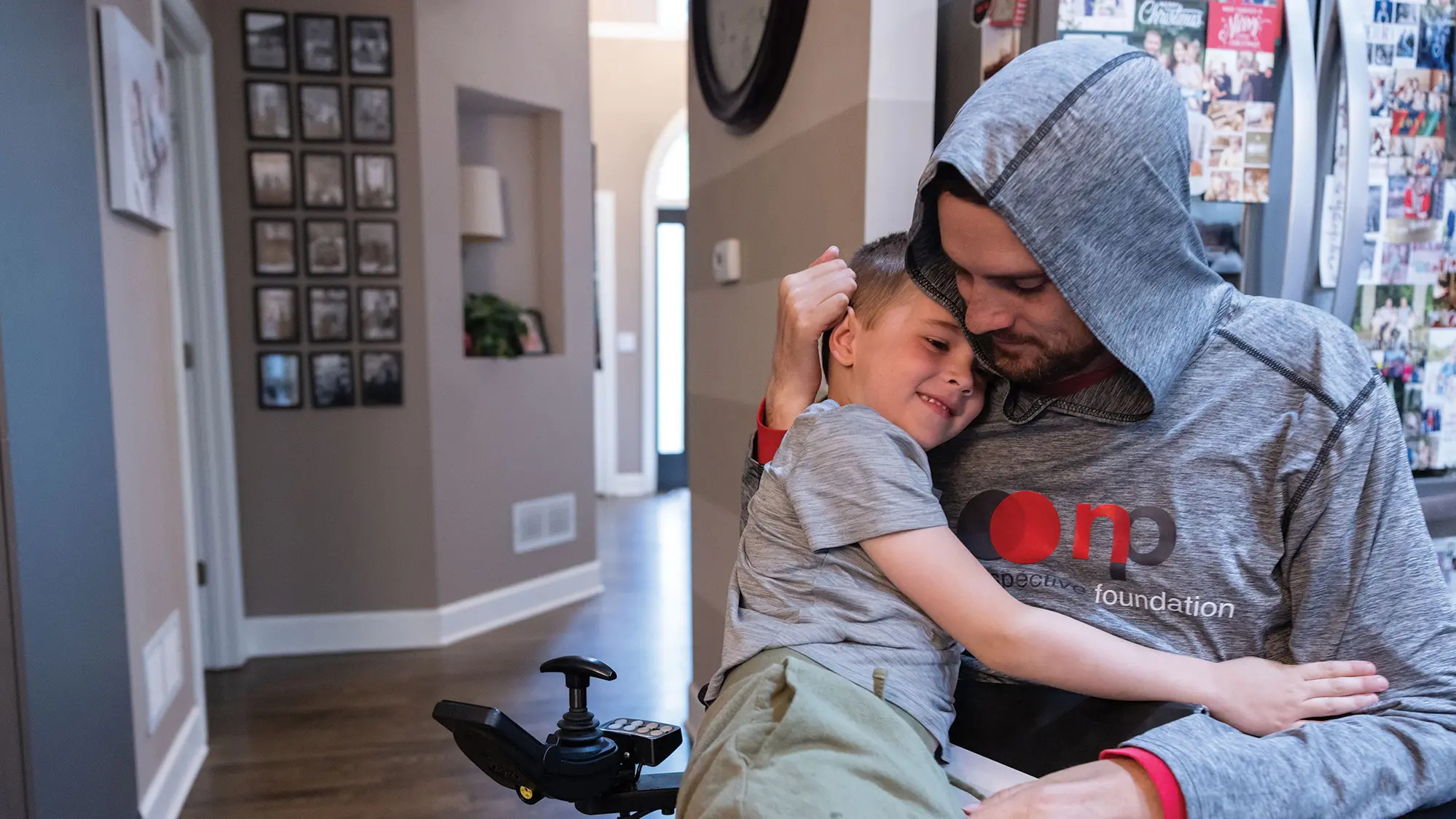
After showing off his new artwork, 5-year-old Ryan gets a hug from his dad. Tyson is wearing his hood because he often feels cold. That is part of why the family, despite deep roots in Ohio, chooses to live in the South. (Photo by Jodi Miller)
“You have no idea how much it affects more than just the person in the hospital bed.”
ALPHARETTA, GEORGIA — Light from a bedroom lamp pierces the 6 a.m. darkness as a couple begins their day, same as they have since they married a decade earlier.
Tyson Gentry is on his back, unable to move his body except for his head, shoulders and upper arms. He has been a quadriplegic since suffering a spinal cord injury as an Ohio State football player in 2006 — three years before he met a fellow student in a class in Independence Hall and they fell in love.
This morning, the classmate he married — Megan Vanderhorst Gentry ’10 — is stretching Tyson for 15 minutes to lessen the chance he’ll have spasms from tightness during his day in a motorized wheelchair.
“She’s amazing,” Tyson says. “She’s my full-time caregiver, literally doing the job of three other people. Megan has made all the negative side effects of my injury bearable. She’s a major part of why I’m thankful for my injury. If not for my injury, I wouldn’t have her, and we wouldn’t have our boys.”
Their sons, Adam, 7, and Ryan, 5, are asleep down a hall of their home, about 25 miles north of Atlanta. They’re minutes from launching into action, always eager to help if needed.
“To a degree, our kids are even Ty’s caregivers because they fill up his drink, pick up his phone,” Megan says. “A caregiver is anybody involved in a person’s life. It’s anybody who just helps lighten the load or fill in the gaps for a person who can’t do it themselves.”
Tyson’s own family is an extension of the support he received immediately after sustaining a broken C-4 vertebra and bruised spine when, as a walk-on receiver, he was tackled during a spring intrasquad scrimmage 17 years ago. He credits the constant presence of his parents and two sisters for providing him strength while he underwent two surgeries at The Ohio State University Wexner Medical Center and two months of inpatient physical and occupational therapy at Dodd Hall.
“It is so important to have your family by your side after your injury,” he says. “That gives so much psychological comfort to the person who is injured.”
With that in mind, Tyson and Megan created and launched New Perspective Foundation in 2015 to aid spinal cord injury patients in Ohio, Georgia and Florida, states where their family has lived. As the foundation’s only two employees, they raise funds to financially assist families and friends who must travel more than 75 miles to be with a loved one who is hospitalized.
“Families have to leave their jobs, so they don’t have income coming in anymore,” Tyson says. “They have to dip into their savings to stay away from home at a hotel or to travel back and forth because they need to work part time back home to make ends meet. The financial burden just adds up so quickly, just so they can be with their loved one.”
Tyson, 37, recalls his parents spending more than $1,000 on gas driving from their home in Sandusky, Ohio, to Columbus and back to be with him after his injury. Fuel cards sent by strangers were among the thousands of messages of encouragement he received from the Ohio State community.
While researching how to make a substantive impact, Tyson and Megan learned travel expenses are a common issue spinal cord patients and their families must deal with, but assistance programs often don’t address them. New Perspective Foundation collaborates with hospital caseworkers to find families it can help by providing up to $5,000 for gas, airfare, rental cars, local transportation, parking and lodging.
“We’re trying to bridge the gap,” Megan says. “We can take a burden off the families by saying, ‘This is something you don’t have to worry about. We’ll take care of it. You focus on other things.’”
This is especially helpful in the emotional, challenging days, weeks and months after a person experiences a spinal cord injury, when identities and roles are dramatically redefined.
“Unless you go through it,” Tyson says, “you have no idea how much it affects more than just the person in the hospital bed and a wheelchair. We’re just grateful to be one resource families can lean on.”
Tyson’s voice is calm and reassuring as he sits near Jacob Kennedy in the paralyzed teenager’s dim room at Shepherd Center, an Atlanta hospital that specializes in spinal cord treatment, research and rehabilitation.
“Nobody’s excited about being in a wheelchair,” Tyson tells Jacob. “But I was telling your mom that there’s going to be a lot of good that comes from this situation. You can’t see that at this juncture, when you’re in the thick of it.”
Elana Kennedy and her husband, Sean, look on, caught in a blur of emotional challenges since their son’s injury in December.
“Some days I wake up and don’t even know what planet I’m on,” Elana says.

Seven-year-old Adam shows his parents a drawing he made in school. (Photo by Jodi Miller)
The Kennedys live in Vienna, Austria, where both parents work for the U.S. Embassy. Jacob, 15, was airlifted to Shepherd Center two months after being electrocuted, falling and breaking three vertebrae. His right arm has been amputated. Mom and Dad are with him now in part because of the $5,000 New Perspective Foundation provided to help cover overseas flights and a rental car.
“It has been a huge relief,” Elana says. “We just have all of these unforeseen expenses. This totally relieves so much stress on us. We also get emotional support from Tyson and Megan. They’re so inspirational, so caring.”
Two blocks away, Lana and Joey May sit inside a quiet, one-bedroom studio at BCA Furnished Apartments, where their three weeks of rent is being paid for by New Perspective Foundation.
“We’re so grateful for this roof over our heads,” Lana says. “We would have had to stay at a hotel, and that’s very expensive.”
Their daughter, Carli Beth Whitehead, 26, suffered a spinal cord injury in a four-wheeler accident in February. She’s being treated at Shepherd Center, which is 225 miles from the family’s hometown of Fayette, Alabama.
“Carli needs us here,” Joey says. “For us to be together, it’s a blessing. It’s amazing what Tyson and Megan are doing. This provides us a place where we can come and just kind of gather ourselves while Carli is in therapy. We can have some moments of downtime, relax and regain our focus.”
The Mays and Kennedys are among 203 families that have been aided by New Perspective Foundation since 2015. Tyson and Megan have raised most of the $400,000 they’ve provided to recipients through a fundraiser held each July in Sandusky, his hometown. They recently applied for grants from the Christopher & Dana Reeve Foundation and the Craig H. Neilsen Foundation in hopes of expanding their nonprofit’s reach.
“Like everything in life, this injury can make you worse or make you better,” Tyson says. “We focus on making things better.”
His attitude helped shape the mindset of Austin Beggin ’15, who was paralyzed when he shattered two vertebrae diving into the ocean on a Florida vacation shortly after graduating from Ohio State.
“Tyson gave me the courage to go pay it forward,” he says. “If I see an opportunity to help somebody in a situation like mine, I talk to them.”
New Perspective Foundation reimbursed Beggin’s family for expenses incurred while traveling from their Lima, Ohio, home to be with Austin during his rehab at Ohio State Martha Morehouse Outpatient Care in Columbus.

Tyson talks with Ohio State receiver Kamryn Babb ’21, ’22 MS during a visit to Columbus in February for the annual scholar-athlete banquet put on by the National Football Foundation’s local chapter. That day, Babb was honored with the Tyson Gentry Courage Award in recognition of the way he pushed forward despite multiple knee injuries and surgeries.
But Tyson’s help exceeded any financial value.
“You’re talking to an experienced spinal cord patient like you, and he has a good quality of life,” Austin says. “It’s special. Makes you think. Makes you not give up or get overwhelmed by the magnitude of what you’re going through. It reminds you that there’s definitely a good life ahead.”
Huge, puffy white clouds dot a bright blue sky above a youth baseball game in Milton, Georgia.
Tyson sits in his wheelchair with Megan beside him. Her parents are with them, and Adam is chomping on a pretzel from Grandma. The family dog is here, too.
Youngest son Ryan walks up to bat. Below “Gentry” on the back of his jersey is the numeral 24 — the same number Tyson was wearing when he was injured.
It’s a long way from a moment 17 years ago at Dodd Hall.
“I was in so much pain,” Tyson recalls. “I was just squeezing my eyes shut, literally praying to die because I just couldn’t do it anymore.”
Life isn’t always easy now. Two years ago, he was in the intensive care unit with viral meningitis and encephalitis. His brain swelled, raising fear it could be fatal.
Still, joy and gratitude reign supreme.
“I’m very blessed,” Tyson says. “A lot of good has come from my injury. It’s tough sometimes, but it’s great to be out here. I’m glad I’m able to watch my son play.”
Ryan hits a slow roller and dashes to first base. He’s safe.
The Gentry family claps and cheers.
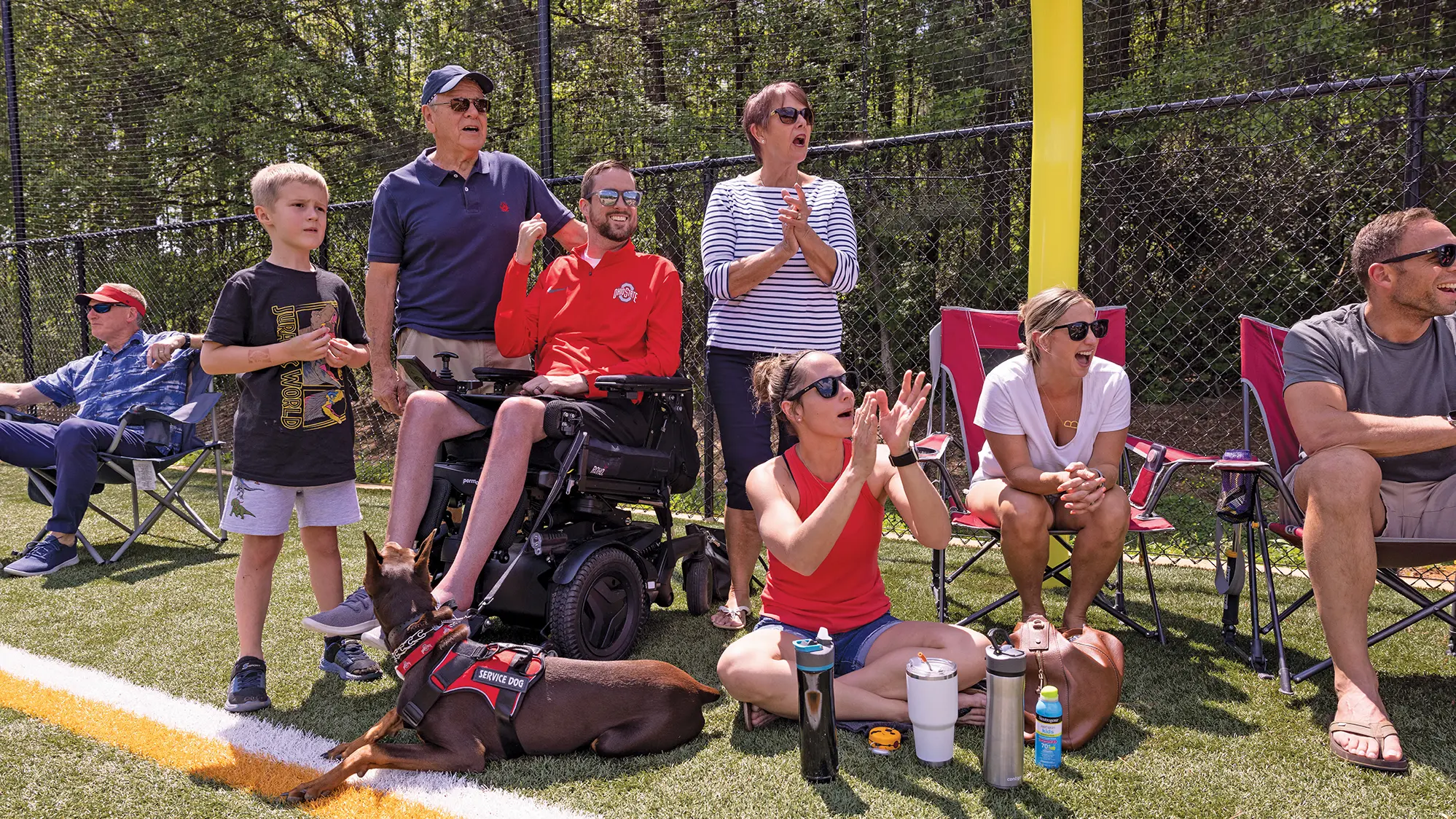
Tyson, Megan (in red), 7-year-old Adam and Megan’s parents Ben ’71 and Jane Vanderhorst watch Ryan play baseball on a beautiful spring day. “People say, ‘I don’t know how you do it,’” Megan says. “It’s definitely a lot of planning but it’s either accept it and do it or sit at home all the time and do nothing. We just do.” (Photo by Jodi Miller)

